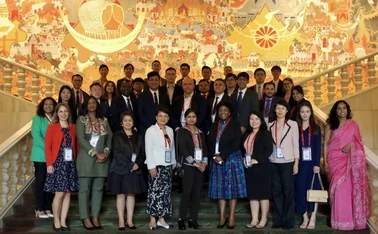
Reform and the Shanghai Free-Trade Zone
The next steps are for China to be included in US and EU-led free trade agreements

It has been over a year since the Shanghai Free-Trade Zone (SHFTZ) started operations. This revolutionary achievement is the culmination of a 36-year period of reform and opening-up that can be divided into four phases. From the late 1970s and early 1980s, China established four Special Economic Zones and 14 open coastal cities.
Then, the Shanghai Pudong New Area was introduced in 1990 and a total of 14 new districts established, including the latest, Qingdao West Coast New Area. Another critical development was China successfully joining the World Trade Organization (WTO) after 15 years of negotiation in December 2001. The fourth phase of reform is the establishment of the Shanghai Pilot Free-Trade Zone.
Comprehensive reform in SHFTZ
The SHFTZ represents policy innovation and has required reform of both policy mechanisms and the legal system. The development can be summarised by four points.
First, two revolutions took place regarding the introduction of the pre-establishment National Treatment and the Negative List of Special Management of Foreign Investment policies. There were legal obstacles that would have prevented the implementation of these two new policies.
The Shanghai-Hong Kong Connect's most profound impact on the SHFTZ is the deepening of the idea of the rule of law
In particular, China's three basic laws - the Law of the People's Republic of China (PRC) on Chinese-Foreign Equity Joint Ventures, the Law of the PRC on Sino-Foreign Co-operative Enterprises, and the Law of the PRC on Wholly Foreign-Owned Enterprises - require foreign investment projects to be examined and approved by government sectors and be managed according to the State Council's terms. But the new policy implemented in the SHFTZ has converted the usual examination and approval system to more of a monitoring system.
In addition, measures for the management of foreign investment were adopted through the use of a ‘negative list', a list of business areas that were not allowed to participate in the SHFTZ.
Therefore, at the fourth session of the Twelfth Communist Party of China's (CPC) Standing Committee on August 30, 2014, an important decision was made: for the subsequent three years, the implementation of the three basic laws would be suspended in the SHFTZ.
This was the first time such a step had been taken since the establishment of the PRC in 1949. Obstacles were removed, while legal guidance and protection were established. On August 1, 2014, the Shanghai Pilot Free-Trade Zone Regulations were implemented, with 59 articles comprising nine chapters covering both the central and local administrative authorities.
This set an example for China's further reform, driven by the rule of law.
Second, was the publication of two ‘negative lists'. Around the world, 76 countries use negative lists to stipulate investments that are not allowed in their respective countries. China's first negative list was formulated in 2013, including 190 restrictive and prohibitive measures, accounting for 17.8% of the 1,069 small-economy industries. Any activity that is not on the list is considered legal.
The second negative list was formulated in 2014, with fewer special management measures, as 51 articles were removed. However, the openness and transparency of the list was strengthened, moving it closer to the international standard.
 Third, two significant opening-up policies were implemented. Since its start on September 29, 2013, the SHFTZ has gradually opened up business sectors, including the financial, shipping, commerce, professional services, cultural and social segments. Within nine months, 23 reform measures on 18 aspects in six sectors have been successfully carried out. The 31 new articles were introduced on July 1, 2014, with 14 articles focusing on the service industry, 14 on manufacturing, two on mining and one on infrastructure. A total of 54 measures had been carried out through the two policy reforms.
Third, two significant opening-up policies were implemented. Since its start on September 29, 2013, the SHFTZ has gradually opened up business sectors, including the financial, shipping, commerce, professional services, cultural and social segments. Within nine months, 23 reform measures on 18 aspects in six sectors have been successfully carried out. The 31 new articles were introduced on July 1, 2014, with 14 articles focusing on the service industry, 14 on manufacturing, two on mining and one on infrastructure. A total of 54 measures had been carried out through the two policy reforms.
Fourth, two great reforms occurred in the government examination and approval system. On December 21, 2013, China's State Council passed a bill to suspend the 32 examination and approval regulations in the SHFTZ. And in September 2014, the council approved the suspension of 27 examination and approval regulations in the SHFTZ, with the total number of regulations suspended reaching 59.
The four points listed above demonstrate the comprehensive nature of the reforms implemented in the SHFTZ and show how China's reforms have converged on international standards.
Negotiation and development of SHFTZ
Further development of the SHFTZ should focus on three multilateral negotiations and one bilateral negotiation.
The first multilateral negotiation is the Trans-Pacific Partnership (TPP) agreement, led by the US. It has been ongoing for about 10 years, focusing on tariff exemptions and the enhancement of non-tariff measures.
Although the US has stated it will not accept any new members before any agreement is reached, China's participation in this negotiation would certainly be meaningful for the present and future agreements reached.
The second negotiation is the Transatlantic Trade and Investment Partnership (TTIP), led by the US and European Union, which would have an influence on China despite the lack of Chinese participation.
This negotiation has been going on for two years. Once concluded, the TTIP, covering 29 sovereign states, would lead to the world's largest free-trade zone and promote economic and trade co-operation between both sides of the Atlantic Ocean. The third negotiation is the Trade in Services Agreement (Tisa), which now has 50 members and covers 70% of the world's trade in services. The three negotiations are related to tariff issues, nontariff issues and the expansion of core investment.
International finance and investment are closely connected. The expansion of the investment sector is not only linked to direct and indirect investment, but also the internationalisation of the renminbi. Before the full internationalisation of the renminbi, we should guarantee foreign investors can profit freely and transfer funds in a timely manner. Since China joined the WTO in 2001, the country has fulfilled two-thirds of its promise of opening up the service and trade sector.
The rest of its undertaking - that is, the opening-up of the remaining sectors - is much harder to fulfil. Future investment disputes should be presented to the International Centre for Settlement of Investment Disputes, which is located in the US. The measures China took to settle an anti-dumping WTO dispute in 2013 is a good reference.
In addition, there are the important China and US negotiations on bilateral investment, which started in 2009 and have gone through 13 rounds.
China is emerging as a net capital outflow country for the first time. However, the country has still not established a bilateral investment agreement with either the US or the EU. The SHFTZ should have foresight, actively initiating comprehensive experiments, establish a fair investment environment and protect investors' and workers' rights, the environment and intellectual rights. The SHFTZ is expected to be fully prepared for the new challenges included in the negotiations mentioned earlier.
Impact of Shanghai-Hong Kong Stock Connect
First of all, the Shanghai-Hong Kong Stock Connect programme has given Shanghai, particularly the SHFTZ, an opportunity to be further globalised. The connection between the Shanghai and the Hong Kong stock exchanges will bring more direct fair competition at an international level, and it also strengthens the idea of liberalisation. The Shanghai-Hong Kong Connect's most profound impact on the SHFTZ is the deepening of the idea of the rule of law. The public companies' self-management, annual reporting systems, etc, will all be included in the framework of the rule of law.
Finally, as UK prime minister Winston Churchill said during the Second World War, "this is not the end". This is not even the beginning of the development of the SHFTZ. But it is, perhaps, the end of the beginning.
Only users who have a paid subscription or are part of a corporate subscription are able to print or copy content.
To access these options, along with all other subscription benefits, please contact info@centralbanking.com or view our subscription options here: http://subscriptions.centralbanking.com/subscribe
You are currently unable to print this content. Please contact info@centralbanking.com to find out more.
You are currently unable to copy this content. Please contact info@centralbanking.com to find out more.
Copyright Infopro Digital Limited. All rights reserved.
As outlined in our terms and conditions, https://www.infopro-digital.com/terms-and-conditions/subscriptions/ (point 2.4), printing is limited to a single copy.
If you would like to purchase additional rights please email info@centralbanking.com
Copyright Infopro Digital Limited. All rights reserved.
You may share this content using our article tools. As outlined in our terms and conditions, https://www.infopro-digital.com/terms-and-conditions/subscriptions/ (clause 2.4), an Authorised User may only make one copy of the materials for their own personal use. You must also comply with the restrictions in clause 2.5.
If you would like to purchase additional rights please email info@centralbanking.com








